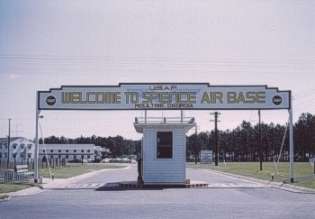This web site
conveys, in word and picture, a brief history of
Spence Air Base, a base that performed a vital
training function during two wars, and completed
it's second military mission in March,
1961. It is dedicated to the personnel,
both military and civilian, who played a role in
the operation of Spence Air Base during its two
terms as a military air training center.
Although military operations covered by this web
site ceased long ago many still look back on
their tour of duty at Spence among their most
challenging, rewarding and enjoyable life
experiences. This site is dedicated also
to the fine people of Moultrie, Georgia and
surrounding area who graciously accepted those
who served at Spence, took us into their homes
and hearts and by their actions taught us the
true meaning of “southern hospitality”.
* * * * * *
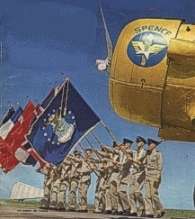 In 1941, before the United States was
actively engaged in World War II, a new Army Air
Force base was carved from some 1600 acres of
tobacco and cotton fields a few miles southeast of
Moultrie, Georgia. It was named Spence Air
Base after World War I hero Lt. Thomas Lewis
Spence of Thomasville, Georgia. When the
attack on Pearl Harbor came on December 7, 1941 a
small military detachment of 27 officers and 39
enlisted men staffed Spence Air Base.
In 1941, before the United States was
actively engaged in World War II, a new Army Air
Force base was carved from some 1600 acres of
tobacco and cotton fields a few miles southeast of
Moultrie, Georgia. It was named Spence Air
Base after World War I hero Lt. Thomas Lewis
Spence of Thomasville, Georgia. When the
attack on Pearl Harbor came on December 7, 1941 a
small military detachment of 27 officers and 39
enlisted men staffed Spence Air Base.Spence grew rapidly into an Advanced single engine training base that functioned throughout the war and trained nearly 6000 pilots by the time the base closed in November of 1945. The last several months of operation, from February 1945 until the base closed it served as a Basic flight training site. Spence was reactivated in 1951 during the Korean conflict due to the increased need for well trained military pilots. The base had deteriorated badly over its six idle years and a major renovation project was required to return it to acceptable standards. Repair work was still underway when the first United States Air Force (USAF) class, Class 52-C, reported for training in May 1951.
On
it’s second military mission Spence operated as a
Contract Primary Flying Training base - a training
system where a civilian contractor provided
professional flight, maintenance and support
personnel to train military students, in military
aircraft, to military standards, with their
training monitored by a specialized military team
selected for that purpose. It was one of
nine
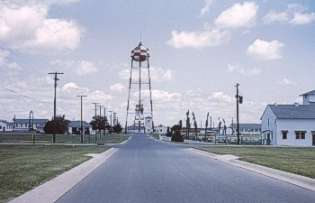 contract
bases activated during the Korean conflict era and
was among the last of this group to be phased out.
The contract training concept was first introduced
during World War II by General “Hap” Arnold and
resulted in most World War II Army Air Force
pilots receiving some of their training in one of
the over 60 contract schools that operated during
that war. contract
bases activated during the Korean conflict era and
was among the last of this group to be phased out.
The contract training concept was first introduced
during World War II by General “Hap” Arnold and
resulted in most World War II Army Air Force
pilots receiving some of their training in one of
the over 60 contract schools that operated during
that war.
The civilian
contractor for the Spence operation was Hawthorne
Flying Service of Charleston, South Carolina
operating under the name Hawthorne School of
Aeronautics. Hawthorne had operated contract
schools during World War II so was well qualified
for the new assignment. President of Hawthorne
was world famous aerobatic pilot Beverly E. “Bevo”
Howard. Military supervision was provided by
the 3302nd Pilot Training Squadron of the USAF Air
Training Command.
Instructor Pilots and Flight Supervisors were selected from a pool of ex-military and professional civilian pilots who were then given further training at the USAF Instructor Pilot School at Craig Air Force Base, Selma, Alabama. Flight students were USAF aviation cadets and student officers interspersed with additional trainees from other U.S. military services plus trainees from over 30 allied countries. Students and instructors alike were spot checked periodically by 3302nd military check pilots and by a traveling USAF standardization board to insure that training conformed to strict USAF standards. Spence was noted for both its standardization and safety record and received several USAF commendations for both. 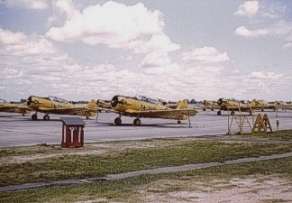 Spence flight students
flew the finest of military training aircraft
available at that time. In the earlier classes
students flew the North American T-6G,
the latest version of the legendary AT-6 advanced
trainer of World War II, during their entire flight
curriculum. Time proved that the T-6 was a
major challenge for some beginning students and the
Piper PA-18 was added to the training fleet.
The PA-18 was a less complex aircraft that permitted
early screening of flight students and allowed
students to develop some degree of proficiency
before advancing to the more sophisticated
T-6. In 1953-54 the T-6 was replaced with the
more modern North American T-28 and in 1955 the new
Beechcraft T-34 replaced the PA-18. The T-34
& T-28 were the standard trainers until 1959-60
when the new Cessna T-37 jet trainer was phased in
replacing the T-28 and it remained until military
flight operations at Spence were terminated. Spence flight students
flew the finest of military training aircraft
available at that time. In the earlier classes
students flew the North American T-6G,
the latest version of the legendary AT-6 advanced
trainer of World War II, during their entire flight
curriculum. Time proved that the T-6 was a
major challenge for some beginning students and the
Piper PA-18 was added to the training fleet.
The PA-18 was a less complex aircraft that permitted
early screening of flight students and allowed
students to develop some degree of proficiency
before advancing to the more sophisticated
T-6. In 1953-54 the T-6 was replaced with the
more modern North American T-28 and in 1955 the new
Beechcraft T-34 replaced the PA-18. The T-34
& T-28 were the standard trainers until 1959-60
when the new Cessna T-37 jet trainer was phased in
replacing the T-28 and it remained until military
flight operations at Spence were terminated.
Flight training took place at Spence, the home field, plus three auxiliary fields, Thomasville, Tifton and Sunset Field south of Moultrie. 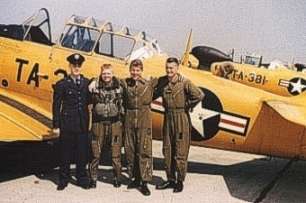
Flight operations
varied somewhat over time but typically consisted of
two squadrons of four flights each. Flights
normally included a Flight Commander, Assistant
Flight Commander, Standardization Leader, Safety
Leader and about fifteen additional instructors,
depending on the size of the class. Four
students were assigned to each instructor.
Students alternated between morning and afternoon
flight schedules with other required training during
the remaining half-day. Actual flying training
typically entailed 30 hours in the smaller first
phase aircraft and another 100 hours in the more
complex second phase aircraft, all flown in a six
month period. Students were trained in
fundamental through advanced maneuvers, night
flying, instrument flying, navigation and
aerobatics. A student class graduated and a
new class started every six weeks. Graduates
went on to a Basic Training base for an additional
six months and upon satisfactory completion of that
phase of training Cadets were commissioned and all
graduates received their coveted silver wings.
Advanced training followed, with eventual
operational assignments.
While flying training was the primary mission at Spence little would have been accomplished without the dedicated support groups that worked hand-in-hand with the Flight Department. Departments of Academic Training, Flight Safety, Aircraft Maintenance, Base Supply, Base Engineering and Maintenance, Food Services, Accounting and Industrial Relations all fell under the umbrella of responsibility of Hawthorne School of Aeronautics. All departments contributed significantly to fulfilling the primary mission. 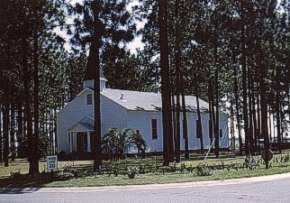 Spence Air Base was a
model of cooperation between military and civilian
personnel with strong support from the surrounding
community. All worked in concert to successfully
accomplish an important mission. Spence, in the
1951-61 decade, saw over a million hours flown, with
over 2.5 million take offs and landings and over 6400
flight students successfully completing their training
courses. In addition to flight trainees from the
United States students were trained from Belgium,
Bolivia, Brazil, Chile, Columbia, Cuba, Denmark,
Ecuador, France, Germany, Great Britain, Greece,
Guatemala, Honduras, Iran, Iraq, Italy, Japan, Korea,
Netherlands, Nicaragua, Norway, Pakistan, Paraguay,
Peru, Philippine Islands, Puerto Rico, Saudi Arabia,
Spain, Thailand, Turkey, Venezuela, and Viet
Nam. It was indeed a decade of accomplishment
for all involved. Spence Air Base was a
model of cooperation between military and civilian
personnel with strong support from the surrounding
community. All worked in concert to successfully
accomplish an important mission. Spence, in the
1951-61 decade, saw over a million hours flown, with
over 2.5 million take offs and landings and over 6400
flight students successfully completing their training
courses. In addition to flight trainees from the
United States students were trained from Belgium,
Bolivia, Brazil, Chile, Columbia, Cuba, Denmark,
Ecuador, France, Germany, Great Britain, Greece,
Guatemala, Honduras, Iran, Iraq, Italy, Japan, Korea,
Netherlands, Nicaragua, Norway, Pakistan, Paraguay,
Peru, Philippine Islands, Puerto Rico, Saudi Arabia,
Spain, Thailand, Turkey, Venezuela, and Viet
Nam. It was indeed a decade of accomplishment
for all involved.The skies over Moultrie and vicinity were relatively quiet for many years following the base closure in 1961 but it was not always so. The older folks of the Moultrie area and aging pilots worldwide remembered when those same skies were filled with graceful aircraft training fine young airmen to become competent military pilots in order to help protect and defend freedom throughout the world. Sources: Hawthorne publications SPENCE AIR BASE and THE SPENCE STORY, personal knowledge gained as an instructor pilot and standardization leader at Spence Air Base, plus information and photographs contributed by many fine people who shared in the Spence experience. This web site is a works in progress and subject to additions and modification as time goes on - Bruce R. Watson Note: Since launching the Spence Web site we have learned that Spence was again used by the USAF. It served as an auxiliary field for the pilot training program at Moody AFB, Valdosta, GA being used for take off and landing operations by their T-6 Texan II turbo-prop trainers. For the latest information on Spence click here . |

